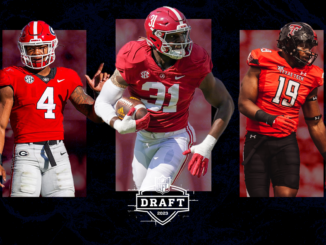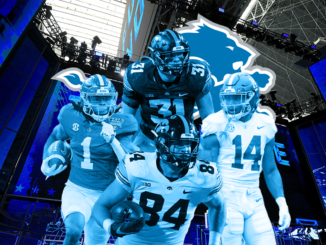This year’s offensive tackle class is garnering plenty of attention, and quite rightly. Whilst there might not be great depth, there are a handful of prospects who look set to have bright futures at the NFL level. Here are my top ten offensive tackles in the 2023 NFL Draft.
You can also download our free 2023 NFL Draft Guide, with over 130 in-depth prospect profiles!
1. Peter Skoronski, Northwestern (6-4, 313, Junior)

Pros: Skoronski is a smart and refined technician in every aspect of the game. He showcases outstanding hand technique, with excellent timing and placement to his punches. He is also comfortable using his hands independently and is active in resetting to maintain control at the point of attack. Skoronski is also a very good athlete, with smooth footwork and easy redirect ability to contain counters. He displays to the explosiveness to be a good puller and execute reach blocks. Few can match the quality of his collegiate tape.
Cons: The most obvious concern with Skoronski is his lack of length. His 32.2″ arms put him in the fourth percentile amongst offensive tackles and he ranks in the ninth percentile with a 79.5″ wingspan. There were a number of times on tape where Skoronski would lean into blocks to compensate for his lack of length and all of this will lead to concerns about whether he can stick at tackle in the NFL. Whilst his anchor is solid, Skoronski may have more issues against bigger NFL edge rushers.
Projection: 1st round
2. Broderick Jones, Georgia (6-5, 311, Junior)

Pros: Jones is a tremendous athlete with outstanding movement skills. He consistently gets great depth out of his stance in pass protection and has the loose hips and quick feet to redirect without any issue. He looks like a natural in space, either on an island in pass protection or out in front as a blocker on screens. His hands pack plenty of power and he will stonewall opponents when he makes first contact. Jones also shows great competitive toughness and aggression as a blocker.
Cons: Jones’ hand technique needs plenty of work. He is still very much reliant on using a two-hand punch. This often results in him overextending and getting himself off balance. His hand timing and placement are also noticeably erratic and will be exploited by smarter edge rushers. Jones is still very inexperienced, having just one season as a starter and playing the fewest collegiate snaps of any draft-eligible FBS offensive linemen.
Projection: 1st round
3. Paris Johnson, Ohio State (6-6, 313, Junior)

Pros: Johnson is a well-rounded athlete who looks very comfortable in space. He possesses outstanding length, with 36.1″ arms that rank in the 97th percentile amongst offensive tackle prospects. His good foot quickness shows up in pass protection and he is adept at redirecting to respond to counters. He is a very fluid and efficient blocker on the move too, making him an asset on zone runs and screens. Johnson offers positional versatility, with double digit starts at both tackle and guard.
Cons: Johnson’s hand technique is still pretty spotty. He tends to utilise a two-hand punch, which will get him into trouble at the NFL level. He also gets too aggressive as a blocker and in his attempts to finish opponents he will often get over his toes and lose balance. Whilst his power is generally solid, you would still like to see him add a little more core strength to improve his ability to anchor consistently against bull rushes.
Projection: 1st round
4. Darnell Wright, Tennessee (6-5, 333, Senior)

Pros: Wright ticks the box when it comes to his measurables, possessing the height, weight, and length to be a good NFL offensive tackle. He pairs this with an impressive power profile and a physical playstyle. His hands are heavy and allow him to easily displace defenders in the running game. This, coupled with his anchor ability, allow him to neutralise the momentum of opposing pass rushers. Wright has four years of starting experience under his belt at both left and right tackle, with his best tape coming against top competition.
Cons: There will be some concerns surrounding Wright’s lateral quickness. This caused him issues in pass protection, where he can struggle to adequately redirect in response to inside counters. His hand placement is also noticeably inconsistent and his timing could certainly use some work. Wright has a frustrating tendency to duck his head into contact, leading to him getting over his toes and losing balance. He also struggled to locate and latch onto defenders at the second level.
Projection: 1st round
5. Dawand Jones, Ohio State (6-8, 374, Senior)

Pros: Jones possesses truly generational size, ranking in the 97th percentile or above in height, weight, arm length, wingspan, and hand size. His power profile is predictably exceptional and he is able to uproot defenders in the running game with ease. He pairs this power with a tenacious playstyle and is aggressive in finishing his blocks and getting his opponents on the deck. Jones is like a block of granite as a pass protector and is almost invulnerable to bull rushes. He is a surprisingly smooth mover for his size too.
Cons: Whilst Jones’ size is his biggest strength, it can also be one of his biggest weaknesses. He has a noticeable tightness in his lower half that presents problems when he is asked to redirect laterally. Quicker and more twitched up edge rushers will give him a problem for this reason. Jones’ height also causes issues with his pad level and he is routinely out-leveraged by opponents. He is still too reliant on a two-hand punch and needs to clean up his technique, with 16 penalties in two years as a starter.
Projection: 1st round
6. Matthew Bergeron, Syracuse (6-5, 318, Senior)

Pros: Bergeron possesses the combination of height, size, and length that teams look for in an offensive tackle. He pairs this with some good technique and an aggressive demeanour as a run blocker. Bergeron is adept at displacing defenders on drive blocks whilst also looking comfortable as a reach blocker on zone runs. He is a smart blocker and looked comfortable handling stunts and twists as a pass protector. He has four years as a starter under his belt and experience playing at both left and right tackle.
Cons: Bergeron is certainly a solid athlete, but he is not much more. This can lead to some issues mirroring quicker edges around the arc. He also has plenty of work to do with his hands. His timing and placement are noticeably erratic, particularly in pass protection. He is routinely late and wide, and lacks ideal core strength to anchor once opponents get inside his frame.
Projection: 2nd round
7. Anton Harrison, Oklahoma (6-4, 315, Junior)

Pros: Harrison is a good athlete with very quick feet. He looks very competent in pass protection, with the depth out of his stance to neutralise speed rushers. He also has the lateral agility to deal with counters effectively. Harrison is a very smart player too, with the ability to quickly identify and pass off stunts and twists. He showcases a solid anchor against power rushers and possesses a good frame. His experience at both tackle spots, as well as the fact he has only just turned 21, will no doubt work in his favour.
Cons: The biggest worry with Harrison is that he lacks the functional strength necessary to displace defenders. He doesn’t seem to make much of an impact in the running game as a result. His hand placement is erratic too, and he needs to be more consistent in striking inside his opponents’ pads. Despite being on the shorter side for an offensive tackle, he does also have issues with his pad level. He also lacks any real sort of mean streak to his game.
Projection: 3rd round
8. Jaelyn Duncan, Maryland (6-6, 306, rs-Senior)

Pros: Duncan is a good athlete with the kind of frame you need to succeed at the NFL level. His foot quickness is impressive and allows him to neutralise speed rushers off the edge. He is also comfortable redirecting laterally when faced with inside counters. These movement skills also make him an asset as a puller on gap scheme runs or as a lead blocker on screens. Duncan also brings plenty of experience, with four years as a starter to his name.
Cons: Duncan’s hand timing and placement are both very inconsistent. He is routinely late and wide with his punches, allowing opponents to make first contact and get inside his frame. Once this happens he lacks the core strength to effectively anchor and hold his ground. Duncan’s poor hand technique was also a big reason for him conceding 31 penalties during his four years as a starter. He has a habit of lunging at his opponents, causing issues with his balance and ability to sustain.
Projection: 3rd round
9. Blake Freeland, BYU (6-8, 302, Senior)

Pros: Freeland ticks all of the boxes when it comes to size and length. He is also a legitimate athlete who set an NFL Combine record for an offensive lineman with a 37″ vertical jump. This, combined with his loose hips and quick footwork, allow him to mirror effectively, allowing just two sacks on 1,418 career pass blocking snaps. His hand placement in the running game is good and he is an asset climbing to the second level. Freeland also offers plenty of experience, with four years as a starter for BYU.
Cons: Freeland is very tall for an offensive tackle and unsurprisingly that comes with some leverage issues. Defenders will routinely get under his pads and he lacks the size and core strength to consistently anchor. This is the kind of problem that will only be more pronounced at the NFL level and he needs to add more weight to have any chance of being a productive NFL starter. Freeland is also reliant on his finesse and lacks the power to consistently move defenders.
Projection: 3rd round
10. Braeden Daniels, Utah (6-4, 294, rs-Senior)

Pros: Daniels is a good athlete who showcases the foot speed and loose hips necessary to hold up as an offensive tackle. He plays the game with good pad level and knee bend, pairing this with strong hands to latch and sustain. He has shown the ability to quickly identify and handle stunts and twists as a pass protector and allowed just one sack over his final two seasons. Daniels’ versatility is one of his biggest strengths, with experience playing at both tackle spots as well as guard.
Cons: Daniels lacks ideal size and will want to add more muscle mass to his frame if he is to succeed at the NFL level. This led to some issues with his anchor strength and he did not look great when asked to handle longer and more powerful rushers. Daniels’ lack of natural power also impacted his ability to create movement in the running game and he would compensate by getting over his toes. He also lacks ideal length, with 33″ arms that put him in the 13th percentile amongst offensive tackle prospects.
Projection: 4th round


